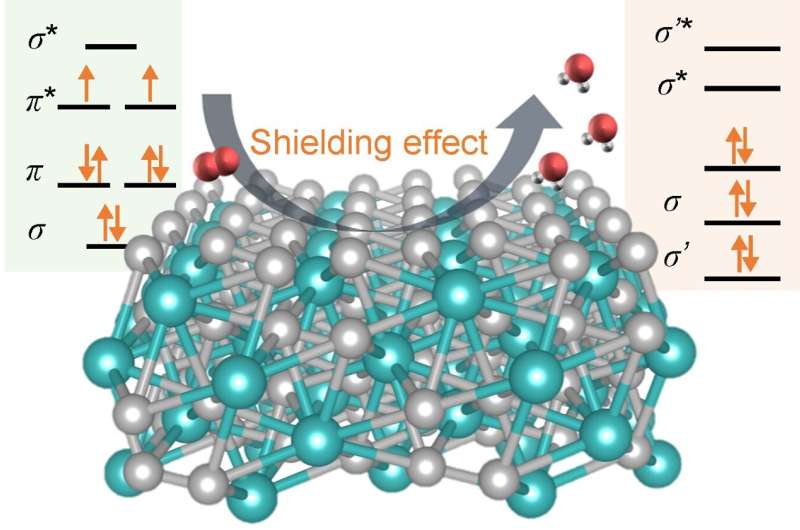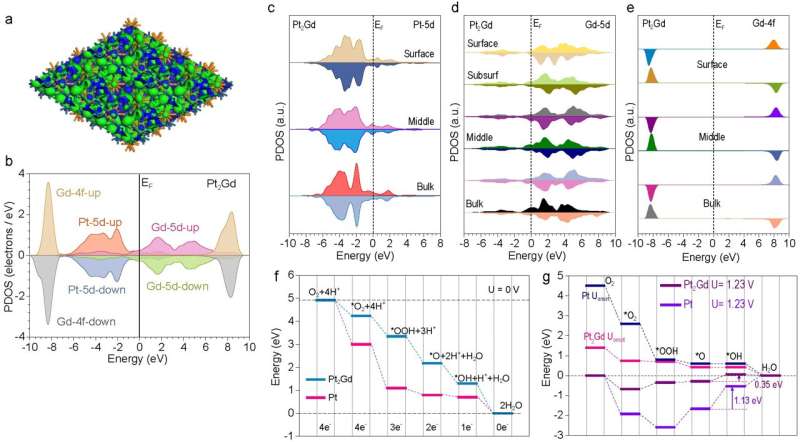This article has been reviewed according to Science X's editorial process and policies. Editors have highlighted the following attributes while ensuring the content's credibility:
fact-checked
trusted source
proofread
New study reveals remarkable impact of intrinsic spin shielding in platinum-rare earth alloys on electrocatalysis

The oxygen reduction reaction is a crucial step in the performance of fuel cells, determining their efficiency and overall applicability. However, sluggish kinetics in the ORR, particularly at the cathode, pose challenges due to its slow and energy-intensive four-electron process. Efforts have been focused on developing platinum-based catalysts with enhanced activity and durability.
One approach has been to alloy platinum with transitional metals, which has been successful in lowering the energy level of the antibonding orbital and boosting the intrinsic activity of platinum.
Recent research has revealed that electrons not only carry charge but also possess spin, which plays a vital role in catalytic reactions. The transformation of oxygen molecules during the ORR involves a variation in spin state, making it essential to consider the interplay between localized spins and electron magnetic interactions.
The spin effect on electrocatalytic reactions, especially those involving spin-flipping, remains poorly understood. Therefore, exploring the spin regulation of catalysts through the engagement of dominant magnetism has become an intriguing avenue for optimizing electron transfer and adsorption strength for localized intermediates.
In this study, researchers successfully incorporated gadolinium (Gd), a rare earth element, into the platinum lattice to create the Pt2Gd intermetallic alloy. Gadolinium possesses intrinsic high spin density due to its half-filled 4f orbitals, resulting in a natural magnetic moment.
The alloy demonstrated a unique intrinsic spin reconfiguration, which significantly impacted the kinetics of the ORR. Experimental results revealed that the Pt2Gd alloy exhibited remarkable electroactivity, including a high mass activity of 1.5 A·mgPt−1 and a half-wave potential of 0.95 V in an acid electrolyte environment. Moreover, it demonstrated superior durability compared to conventional platinum/carbon (Pt/C) catalysts.

Through density functional theory (DFT) calculations, the researchers unraveled the modulations of Pt-5d orbitals induced by the spin reconfiguration brought about by alloying with Gd. The complementary spin polarization between Gd and Pt optimized the electronic structures of Pt, leading to improved adsorption of oxygen intermediates.
Furthermore, the spin shielding effect of Gd-4f orbitals balanced the spin polarizations of Pt-5d, enhancing the reduction capability of Pt sites. This unique interplay between Pt and Gd resulted in a significantly lowered energy barrier for the rate-determining step, contributing to the superior ORR performance observed in the Pt2Gd alloy.
The successful synthesis of rare earth-platinum intermetallic alloys based on metal-organic framework structures has not only overcome the chemical potential difference between single atom rare earth elements and Pt but has also experimentally proven the spin state-performance dependence for the ORR process.
This work opens up new avenues for understanding spin modulation and its profound influence on electrocatalysis. The findings offer important references for the design and development of novel electrocatalysts that harness the spin modulation strategy, promising enhanced ORR activity and catalytic performance.
The discovery of the intrinsic spin shielding effect in platinum-rare earth alloy, specifically the Pt2Gd intermetallic alloy, has provided a significant breakthrough in electrocatalysis. By elucidating the interplay between spin configurations and catalytic activity, researchers have advanced our understanding of spin modulation strategies for optimizing electrocatalytic processes.
This work paves the way for the design of innovative catalysts and holds great potential for the development of highly efficient PEMFCs, contributing to the pursuit of sustainable energy solutions.
The work is published in the journal National Science Review.
More information: Siyuan Zhu et al, Intrinsic Spin Shielding Effect in Platinum–Rare Earth Alloy Boosts Oxygen Reduction Activity, National Science Review (2023). DOI: 10.1093/nsr/nwad162
Provided by Science China Press





















